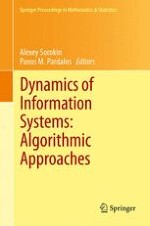
2013 | OriginalPaper | Chapter
Numerical Computations with Infinite and Infinitesimal Numbers: Theory and Applications
Author : Yaroslav D. Sergeyev
Published in: Dynamics of Information Systems: Algorithmic Approaches
Publisher: Springer New York
Activate our intelligent search to find suitable subject content or patents.
Select sections of text to find matching patents with Artificial Intelligence. powered by
Select sections of text to find additional relevant content using AI-assisted search. powered by